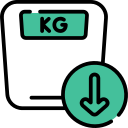Q. How can I tell visceral abdominal fat from ascites? Can ascites be pressed or pinched? Are they both hard to the touch?
Doctor Answer is medically reviewed by SecondMedic medical review team.
Distinguishing between visceral abdominal fat and ascites is crucial for understanding your health. Here's a breakdown:
1. Visceral Abdominal Fat:
Visceral fat is the fat stored around your internal organs, like the liver, pancreas, and intestines. It's not the pinchable fat under your skin but resides deeper within your abdomen.
Look for signs such as a thicker waistline and a firm or hard feeling around the belly. Visceral fat is often associated with an increased risk of cardiovascular issues and type 2 diabetes.
2. Ascites:
Ascites, on the other hand, is the accumulation of fluid in the abdominal cavity. It's not fat but a buildup of fluid that can occur due to various health issues, such as liver cirrhosis, heart failure, or certain cancers.
Ascites can cause abdominal swelling, making the belly appear distended and rounded. It might be accompanied by rapid weight gain and a shifting sensation when changing positions.
How to Differentiate:
- Consistency: Visceral fat feels firm, while ascites presents as a more fluid-based swelling.
- Associated Symptoms: Ascites often comes with symptoms like difficulty breathing and abdominal discomfort, whereas visceral fat may be asymptomatic.
When in Doubt, Seek Professional Advice:
It's essential to consult with a healthcare professional for an accurate diagnosis. They may use imaging techniques like CT scans or ultrasounds to differentiate between visceral fat and ascites.
Prevention and Management:
- For visceral fat, focus on a balanced diet and regular exercise. Cardiovascular activities and strength training can help.
- Ascites management involves addressing the underlying cause, which may require medical intervention.
Understanding the difference empowers you to make informed lifestyle choices. Always prioritize your health, and if you notice any concerning symptoms, don't hesitate to reach out to your healthcare provider. They're your best ally on the journey to a healthier you!
Ascites, a buildup of fluid in the abdominal cavity, is not something you can press or pinch like regular fat. Unlike visceral abdominal fat, which tends to be firmer, ascites feels more fluid-filled and is often described as having a "shifting" or "wave-like" quality when touched.
Ascites is typically caused by underlying health issues, such as liver cirrhosis, heart failure, or certain cancers. When you press on the abdomen, it might feel tense or even distended due to the accumulated fluid. However, it lacks the solid consistency of regular fat.
Visceral abdominal fat, on the other hand, is the fat that surrounds your internal organs. It can feel firm to the touch and is usually distributed in the abdominal cavity. This type of fat, while not as soft as subcutaneous fat (the fat under your skin), is different from the fluid-filled nature of ascites.
It's important to note that attempting to diagnose ascites or any health condition through self-examination is not recommended. If you suspect ascites or have concerns about your abdominal health, it's crucial to consult with a healthcare professional. They can perform a physical examination, order appropriate tests, and provide an accurate diagnosis.
In summary, ascites is not hard to the touch but rather has a fluid-like consistency, in contrast to the firmer feel of visceral abdominal fat. If you have any concerns about your abdominal health, seek professional medical advice for an accurate assessment. Your health is a priority!
Related Questions
-
What role does the heart's electrical system play in regulating heart rhythm? | Secondmedic
-
How is high blood pressure typically treated, and what medications are commonly prescribed? | Secondmedic
-
What are the different treatment options available for heart disease, and how is the best approach determined for an individual patient? | Secondmedic












